Gardening for wildlife has become a favorite backyard hobby for millions of people. This page is designed to give you ideas on turning your backyard into a wildlife garden, with helpful tips on how to arrange food, water, and shelter elements of habitat for wildlife. The Wild Acres site can also help you as you plan your garden with more in-depth information on specific topics such as
wildflower meadows. Always be sure your wildscape plans comply with local ordinances.
Once your wildscape is planted, the fun really begins as you observe and discover wildlife as they discover your wildscape. The wildlife species that will visit your backyard is largely determined by the location of your backyard in proximity to other backyards or undisturbed open space. Wildlife visiting backyards in Western Maryland will differ from backyards on the Eastern Shore, but songbirds, hummingbirds, deer, frogs, turtles, butterflies, squirrels, rabbits, and chipmunks are just a few of the species you may observe enjoying your wildscape. The age of your neighborhood also plays a part in what species will be attracted to your wildscape. Wildlife that need old trees as residences will begin to frequent neighborhoods with large trees but new neighborhoods with young trees tend to lack such wildlife.
Always be sure to consider space, light, soil and watering requirements of each plant before planting them in your wildscape. Plant nurseries and garden centers are good sources for plant care information. Use organic solutions to insect and disease problems instead of pesticides whenever possible. Check out the page on
Beneficial Insects to learn more about insects that can work for you as well as alternatives to pest control.
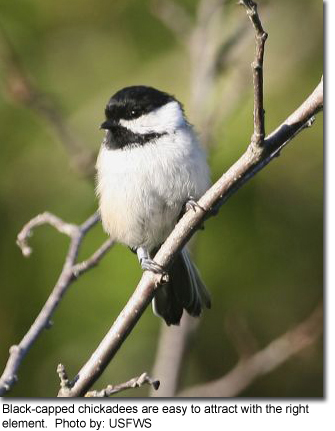
Diversity is the Key
Some large lots are comprised of grass with very little landscaping. The key to creating excellent wildlife habitat, regardless of the total size of the yard, is to offer a diverse habitat. Small trees and shrubs should form the "backbone" of the garden with lower growing annuals and perennials planted in front. Create a diversity of vertical habitat by planting groundcovers and arbors in addition to trees, shrubs and flowers. These plants form layers of habitat that are attractive to a greater number of wildlife species than if you just planted grass and trees. Also, select plants that do "double duty" in the wildlife garden by serving as food and shelter, which is especially important where space is limited.
How much grass should you keep? If you have children or pets, then some grass is necessary. A general rule of thumb is to have 60% or more of your yard area (excluding the house) planted in something other than grass. This rule is for the person who wants to retire their mower completely and incorporates a diverse blending of shrubs, annuals, perennials and vines in an arrangement that makes good use of available vertical space. Other vertical components adding dimension to the design include window boxes and a grape vine.
Habitat Elements
Food
Trees, shrubs and flowers represent important food components in the wildlife garden. Plants provide food in the fruit they produce, including seeds, berries, or nuts, or serve as food themselves. Plants should be chosen so that a variety of plants flower and fruit all season, which ensures a natural food supply will always be available to wildlife. Also, keep in mind the fruiting characteristics of plants. Inkberries and yews are dioecious, meaning that male and female flowers are on separate plants. If berries are desired as a food component than a male and female must be planted near each other. It's also imperative to prune these shrubs carefully and at the proper time of year to make sure you don't severely prune off your future food supply.
Annuals and perennials are excellent sources of nectar for hummingbirds, butterflies, bees and moths. After flowering, some annuals and perennials produce seeds that are enjoyed by songbirds. Be sure to select flower varieties that produce single rather than double flowers because singles are richer sources of nectar. Annuals, as a general rule, flower for a longer period than perennials and can provide vivid colors. Perennials should be chosen so that something is flowering throughout the season. Some of the best bee and butterfly plants are herbs, which when planted, can also add to your kitchen creations.
Water
Fresh water is probably the most important habitat element that you can add to your wildlife garden. There are many kinds of pedestal birdbaths commercially available. A ground birdbath placed in the garden with a circulating pump and mister may attract shy warblers and is a good choice for yards that aren't accessible to free-roaming predators (like cats). A shallow saucer or dish filled with fresh water does just as well. There are also birdbaths commercially available that can attach directly to porch and deck railings that are just as useful for birds to drink and bathe. A saucer filled with sand and kept wet provides water and nutrients for butterflies and toads too! Larger properties may also have streams and backyard ponds which can provide a sufficient water source for wildlife.
Shelter
Evergreen trees and shrubs and bushy or thorny deciduous shrubs can provide shelter for wildlife, even when planted near to the house in a foundation bed. Depending on the shrub, birds may even nest in it. Wildlife need shelter from the weather and safe places to rest and nest away from predators. Planting evergreens near feeders can provide year-round shelter for birds.
A grape arbor provides a nice shady retreat for both you and wildlife. In addition to these plant components, bird nesting boxes also provide important shelter for many wildlife species to raise their young. Roosting boxes provide safe places for resting and protection from the elements. If you have a shady spot with some space, then consider adding a
toad abode to the landscape.
If you have the space, then consider leaving
Snags and Logs or creating
Brush Piles for cover.
Recommended Plant List
The following list provides some recommendations for wildlife friendly plants. When selecting plants, keep in mind the size of your space as well as soil and light requirements for the plants you install. Also, be an informed consumer and stay away from plants that are known to be invasive. For a list of commonly planted invasive species, check out the “Bad Plants Planted by Good People” page.
Annuals
|
Species |
Native? |
Flower/Fruit |
Benefits |
| Cosmos | N | Jun-Aug | Attractive to bees and butterflies |
Flowering Tobacco
(Nicotiana alata) | N | May-Jul | Attractive to bees, butterflies and birds. |
Hollyhocks
(Alcea spp.) | N | | Attractive to bees and butterflies; biennial |
Pentas
(Pentas spp.) | N | Jun-Sept | Nectar attracts bees, butterflies, birds |
Petunia
(Petunia spp.) | N | Apr-Jul | Can attract butterflies like Painted ladies |
Salvia
(Salvia spp.) | N | May-Sep | Great for beneficial insect pollinators |
Sunflowers
(Helianthus annuus) | N | Jun-Aug | Attracts butterflies, bees, beneficial insects, birds and small mammals |
Sweet William/Phlox
(Phlox divaricata) | Y | Apr-Jun | Showy spring flower that attracts butterflies |
Sweet William
(Dianthus barbatus) | N | Jun-Jul | Attracts butterflies and hummingbirds |
| Zinnia | N | | Great for butterflies and other pollinators |
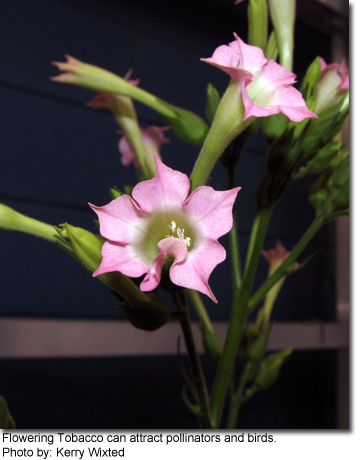
Grasses
|
Species |
Native? |
Flower/Fruit |
Benefits |
Big Bluestem
(Andropogon gerardii) | Y | Jun-Sep | Clump forming plant which provides cover |
| Eastern Gamagrass
(Tripsacum dactyloides) | Y | Jun-Oct | Clump forming plant which provides cover and seeds for wildlife |
Indiangrass
(Sorghastrum nutans) | Y | Aug-Oct | Clump forming plant which provides cover |
| Little bluestem
(Schizachyrium scoparium) | Y | Aug-Oct | Clump forming plant which provides cover and seeds for wildlife |
Purpletop
(Tridens flavus) | Y | Aug-Oct | Best in dry fields; provides cover |
Switchgrass
(Panicum virgatum) | Y | Jul-Oct | Clump forming plant which provides food for sparrows and other songbirds |
Virginia wild rye
(Elymus virginicus) | Y | Jun-Oct | Clump forming plant which tolerates a wide range of conditions |
Wild Oats
(Chasmanthium latifolium) | Y | Jul-Sep | Provides cover |
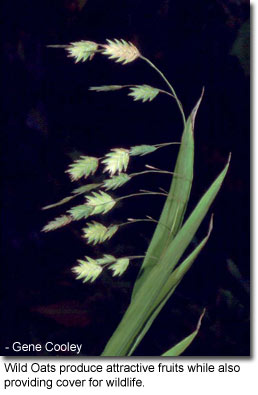
Herbs*
|
Species |
Native? |
Flower/Fruit |
Benefits |
Dill
(Anethum graveolens) | N | | Host for Black swallowtail larvae |
Fennel
(Foeniculum vulgare) | N | | Host for Black swallowtail larvae |
Rosemary
(Rosemaryinus officinalis) | N | | Good for bees |
Sweet Marjoram
(Origanum vulgare) | N | | Good for bees |
Thyme
(Thymus) | N | | Excellent for bees |
| * Note: many herbs can be aggressive in the garden, so it is best to plant them in containers |
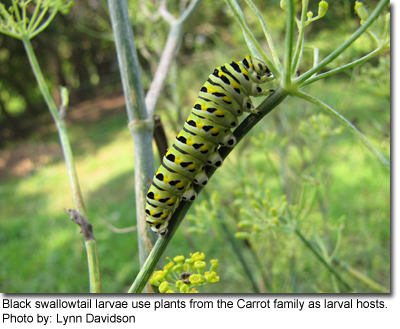
Perennials
|
Species |
Native? |
Flower/Fruit |
Benefits |
Beebalm
(Monarda didyma) | Y | Jul-Sep | Showy, aromatic flowers which attract hummingbirds and butterflies |
Beardtongue
(Penstemon digitalis) | Y | Jun-Aug | Great for hummingbirds |
Black-eyed Susan
(Rudbeckia hirta) | Y | Jun-Oct | Provides both a pollen and nectar source for wildlife |
Blazingstar
(Liatris spicata) | Y | Jul-Aug | Nectar source for butterflies and beneficial insect; grows in dry soil |
Butterflyweed
(Asclepias tuberosa) | Y | May-Jul
Aug-Nov | Host plant for monarch butterflies. Also attracts adult butterflies |
Common Milkweed
(Asclepias syriaca) | Y | May-Jun
Aug-Nov | Host plant for butterflies; fragrant and attracts beneficial insects |
Goldenrods
(Solidago spp.) | Y/N | | Attracts butterflies and beneficial insects |
Ironweed
(Vernonia noveboracensis) | Y | Aug-Oct | Host plant for butterflies |
Joe Pyeweed
(Eupatorium fistulosum) | Y | Jul-Oct | Attracts songbirds, butterflies and beneficial insects; great for rain gardens |
Larkspurs
(Delphinium spp.) | Y/N | Apr-Jun | Provides nectar for butterflies and beneficial insects |
Lupine
(Lupinus perennis) | Y | Apr-Jun | Prefers sunny areas and acidic soil; host plant for butterflies |
Partridgeberry
(Mitchella repens) | Y | May-Jul
Jul-Dec | Groundcover that provides berries for birds and small mammals |
Purple Coneflower
(Echinacea purpureum) | Y | Jul-Aug | Provides nectar for pollinators as well as seeds for birds |
Stonecrops
(Sedum spp.) | Y/N | | Provides good groundcover and some varieties are used by butterflies |
Turk’s Cap Lily
(Lilium superbum) | | | |
Wild Bleeding Heart
(Dicentra eximia) | Y | Apr-Sep | Good for songbirds and beneficial insects |
Wild Columbine
(Aquilegia canadensis) | Y | Apr-Jul | Great for butterflies, hummingbirds and beneficial insects |

Shrubs
|
Species |
Native? |
Flower/Fruit |
Benefits |
Blueberries
(Vaccinium spp.) | Y/N | | Provide berry source for birds as well as nectar source for butterflies and bees |
Coralberry
(Symphoricarpos orbiculatus) | Y | Apr-Jun | Provides cover, nectar for insects, berries for songbirds and leaves for moths |
Dogwoods
(Cornus spp.) | Y/N | | Provides cover and berries for birds and small mammals |
Elderberry
(Sambucus canadensis) | Y | May
Jun-Jul | Fragrant flowers and berries important for songbirds and small mammals |
Hydrangea
(Hydrangea spp.) | Y/N | Jun-Aug | Provides cover and food for pollinators |
Inkberry
(Ilex glabra) | Y | May-Jun
Sep-Mar | Provides cover and berries for songbirds and small mammals; need a male and female for berries |
Juniper
(Juniperus spp.) | Y/N | | Provides year-round shelter |
Rhododendron
(Rhododendron maximum) | Y | May-Aug
Sep-Nov | Provides year-round shelter for wildlife |
Sweet Pepperbush
(Clethra alnifolia) | Y | Jul-Aug
Sep-Feb | Fragrant and attracts butterflies, beneficial bugs, songbirds and waterfowl; provides cover and food |
Viburnums
(Viburnum spp.) | | | Produce fruits enjoyed by songbirds and small mammals |
Virginia Sweetspire
(Itea virginica) | Y | Jun-Jul
Aug-Mar | Provides nectar for beneficial insects and fruit for songbirds and small mammals |
Winterberry
(Ilex verticillata) | Y | Jun-Jul
Aug-Feb | Provides cover and berries for songbirds and small mammals; need a male and female for berries |
Yew
(Taxus canadensis) | Y | Mar-May
Jul-Sep | Provides cover and berries for songbirds |
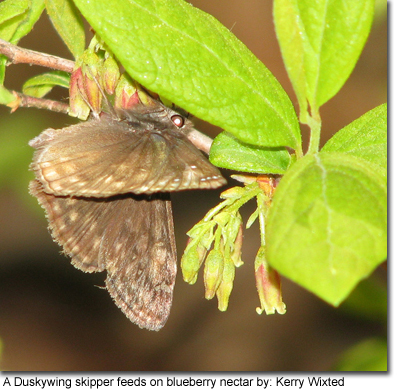
Small Trees
|
Species |
Native? |
Flower/Fruit |
Benefits |
American holly
(Ilex opaca) | Y | May-Jun | Provides year-round cover and berries for songbirds |
Fire Cherry
(Prunus pensylvanica) | Y | May
Jul-Sep | High wildlife value for birds and mammals |
Fringetree
(Chionanthus virginicus) | Y | May-Jun
Sep-Oct | Fragrant flowers and attractive to songbirds |
Flowering Dogwood
(Cornus florida) | Y | Apr-May
Sep-Dec | High wildlife value and showy flowers in spring |
Mountain Ash
(Sorbus americana) | Y | May-Jul
Aug-Dec | High wildlife value for songbirds and small mammals |
Paw-paw
(Asimina triloba) | Y | Apr-Jun
Aug-Sep | Produces edible fruits favored by birds, mammals and people |
Serviceberry
(Amelanchier arborea) | Y | Mar-May
May-Jun | Used by 58 species of wildlife in MD; berries are edible to songbirds, mammals and people |
Sweetbay Magnolia
(Magnolia virginiana) | Y | May-Jul
Sep-Oct | Semi-evergreen and attractive to songbirds, mammals and beneficial insects |
Sumac
(Rhus spp.) | Y/N | | Berries attractive to songbirds and small mammals |
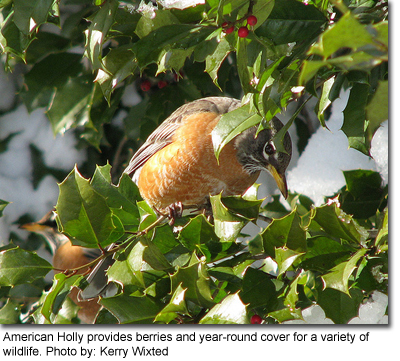
Large Trees
|
Species |
Native? |
Flower/Fruit |
Benefits |
American Beech
(Fagus grandifolia) | Y | Apr-May
Sep-Nov | Nuts edible to small mammals; also attracts songbirds |
American Elm
(Ulmus americana) | Y | Mar-Apr
May | High wildlife value and attractive to nesting Baltimore Orioles |
Bitternut
(Carya cordiformis) | Y | Apr-May
Aug-Oct | Fruits edible to mammals; attractive to songbirds |
Eastern White Pine
(Pinus strobus) | Y | May-Jul
Aug-Oct | Birds and small mammals feed on seeds; provides cover |
Northern Red Oak
(Quercus rubra) | Y | Apr-May | Acorns important for many species of wildlife |
Persimmon
(Diospyros virginiana) | Y | Apr-May
Sep-Nov | High wildlife value; fruits are edible for mammals, birds and people |
Slippery Elm
(Ulmus rubra) | Y | Mar-May | High wildlife value |
Sugar Maple
(Acer saccharum) | Y | Apr-May
Sep-Oct | High wildlife value for songbirds and small mammals |
Tulip Poplar
(Liriodendron tulipifera) | Y | June
Aug-Nov | Attracts hummingbirds, songbirds and small mammals |
White Ash
(Fraxinus americana) | Y | Apr-May
Aug-Feb | Attracts birds, butterflies, beneficial bugs and small mammals |
White Oak
(Quercus alba) | Y | Mar-May
Sep-Oct | Acorns valuable for wildlife; MD state tree; high wildlife value |
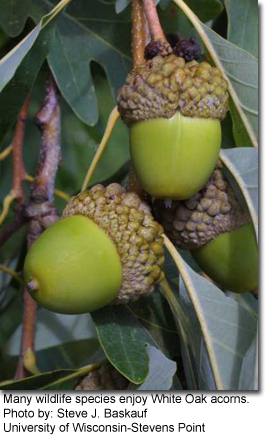
Vines
|
Species |
Native? |
Flower/Fruit |
Benefits |
Bittersweet
(Celastrus scandens) | Y | May-Jun
Sept-Dec | Provides fruits, buds and leaves. Excellent winter food for birds. |
| Oriental bittersweet
(C. orbiculatus) is invasive. | | | |
Passionflower
(Passiflora incarnata) | Y | Jun-Sep
Sep-Oct | Great for butterflies and provides edible fruits |
Trumpet Creeper
(Campsis radicans) | Y | Jul-Sep
Aug-Mar | Great for butterflies and hummingbirds |
Trumpet Honeysuckle
(Lonicera sempervirens) | Y | Apr-Oct
Aug-Mar | Excellent plant for hummingbirds and provides berries for songbirds |
Virgin’s Bower
(Clematis virginiana) | Y | Jul-Sept
Aug-Nov | Fragrant flowers; Note: avoid invasive Japanese clematis |
Wild Grape
(Vitis spp.) | Y/N | | Provides berries for wildlife |
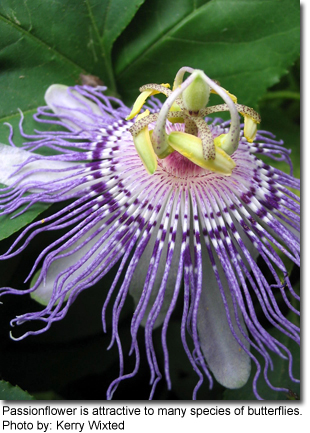
Click here for a PDF version of this webpage for printing or reading purposes.
Invite Wildlife to Your Backyard!
For Additional Information, Contact:
Maryland Department of Natural Resources
Wildlife and Heritage Service
Tawes State Office Building, E-1
Annapolis MD 21401
410-260-8540
Toll-free in Maryland: 1-877-620-8DNR
[email protected]
Acknowledgements:
- Black-capped chickadee photo by: USFWS
- Wild Oats picture by Gene Cooley
- Black swallowtail caterpillar picture by Lynn Davidson
- White oak acorns by: Steve J. Baskauf, University of Wisconsin- Stevens Point
- All other photos by Kerry Wixted